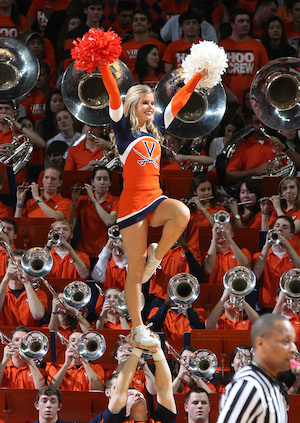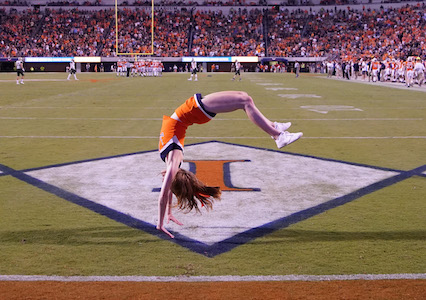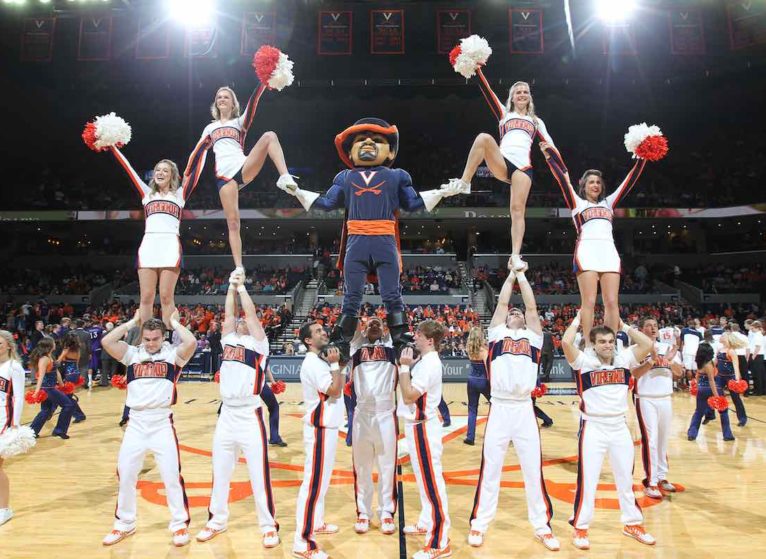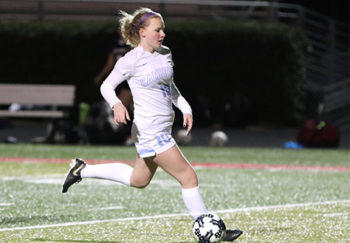No longer a sideline spectacle, cheerleading has changed drastically over the past century. It’s evolved into a true sport, a display of intense physical skill.
Cheerleaders try to wow the audience with new skills and routines at every game or event. One of UVA’s own cheerleaders, Alexandra Dimas, shares, “We do this because we love this sport. We’re always smiling even when we’re pushing through the exhaustion.”
Mega stunts like pyramids, tumbling, and basket tosses put fans in awe. But do you know how much athletic, acrobatic and gymnastic hard work goes into these routines?
How COVID-19 is Changing Sports
I sat down with some of UVA’s cheerleaders in February to talk about their sport. Then the COVID-19 outbreak happened. Grounds were closed, and students went home to finish the semester. Now, with a new school year and hopefully a new season, Coach Kelley Haney is getting ready for a new and interesting season.
Coach Haney just finished a month of virtual tryouts with two rounds. Next, virtual tryouts will be with male athletes for the co-ed team. She and the cheerleading team are waiting patiently to see what the future holds for the sport. The sports administrator will need to clear team members and add more safety protocols before they can start practicing.

Getting Into the Squad: Go ‘Hoos Go!
Two former UVA cheerleaders who graduated in May, Dimas and Briana Fuller, have been cheering and competing since elementary school. Once it was time to go to college, there was no question they would continue their cheerleading career. During their senior year of high school, they tried out for the cheerleading program at UVA.
Haney has coached at UVA for over 20 years. She lists the physical requirements for tryouts:
- Standing tuck — flipping backward with knees to chest from a standing position
- Round-off tuck — after landing a round-off, using the momentum to go immediately into a back tuck
- Tumbling pass — a combination of gymnastic tumbling skills
- Stretch full-down — Tossing the flyer into a 360-degree rotation
- Quick toss (all-female) — Throwing the flyer in a standing position before being caught above the base
- Toss liberty (co-ed) — Tossing the flyer as the base catches only one of the flyer’s feet
Cheerleading Positions
Base — athletes that hold and support the flyer in the air during the stunt
Flyer — gets tossed in the air during a stunt
Back — responsible for watching the stunt and helping support the flyer
Clearly, the criteria for making it on a cheerleading squad are difficult, physically demanding, and competitive. Haney confirms that the level of difficulty required has increased over the years.
Strains, Sprains, and Injuries
Orthopedic surgeon David Weiss, MD, sees more minor injuries with cheerleaders than with soccer or softball players. He most often sees strains, sprains, overuse injuries, and wrist or back hyperextensions. The serious injuries range from concussions to spine and head injuries. These happen when cheerleaders do stunts or tumbling and land incorrectly.
During my interview with Dimas, she was waiting for the athletic trainers to clear her following a concussion. During her second year at UVA, she fractured her foot and was unable to cheer for two months. And when she was younger, she experienced sprained ankles.
As a result of the repetitive stress on her body due to tumbling and harsh landings, Fuller had surgery on her knee in high school. The inflamed tissue required medical attention if she wished to continue cheering. And during her first year at UVA, she fell from a pyramid and broke her collarbone.
Preventing Injury
The coaches and staff have instituted several protocols to help avoid these kinds of injuries.
Coach Supervision
For one thing, athletic trainers stay very much involved at practice and games. They monitor the athletes and make sure they’re ready to get back on the mat without harming themselves or others. They also watch for signs of heatstroke, dehydration, or exhausted muscles. These make it more likely for them to fall or drop someone.

Safe Surfaces
Haney explains that the surface determines the difficulty level of pyramids, stunts, and tumbling to ensure the cheerleaders' safety.
Limiting Practice
The UVA cheerleading program doesn’t compete. And it hasn’t since 2000. In order to compete against other top schools, they would have to practice 6-7 times a week. Coach Haney wants this program to be fun and for cheerleaders to have a well-rounded college experience. That kind of schedule would make academic success difficult. And it would also put these athletes at risk of greater physical harm.
Conditioning
Weiss recommends conditioning and staying active, especially during post-season. That’s why, outside of practice, you’ll find cheerleaders at the gym strengthening and conditioning their bodies.
Another former UVA cheerleader, Noah Rempfer, tore his labrum in his shoulder socket outside of cheerleading but required surgery. He continued weightlifting with the athletic trainer’s approval to make sure he’s still in shape after his recovery. As a co-ed team member, Rempfer was part of the base when stunting. It was important to not lose his strength, so he could properly make the toss or hold a flyer above his head.
Last year was Rempfer’s first year cheering. At first, he never thought he would be on the cheerleading team after years of pole vaulting. “There’s a stigma with cheering, that it’s pretty people just yelling,” he explains. But once he sought out something new during his college years, he quickly understood the physical and technical skills required.
Steps to Protect Your Cheerleader
Weiss explains that long hours and multiple practices put stress on the body. This happens even more so with adolescents. With younger children, their growth plates and ligaments are still growing, so they’re more at risk for injuries.
Cheerleading Injury?
Did your cheerleader experience a fall or bad tumble and is now hurt?
So, Weiss encourages parents of children who are interested in cheerleading to ask questions before joining a team. Also, make sure coaches and teammates are very involved, and ensure safety plans are in place.
Your child should participate in a program that follows best practices for injury prevention:
- Athletes should warm up fully before doing stunts or tumbling
- Performances should only happen on surfaces with safe mats or soft flooring
- The coach should have experience and not push athletes beyond their skill sets and limitations
Also, USA Cheer shares some ways to practice safely during the pandemic, in addition to following the local and state government guidelines. They encourage teams to:
- Clean and sanitize surfaces and mats
- Do temperature checks and health assessments at each practice
- Provide handwashing areas
- Allow athletes and staff a virtual option if living with a high-risk person
- Keep the same stunt groups together, avoid mixing them up, and distance the groups
Although the future for team practices and games is uncertain, all cheerleaders are anxious to get back to their sport.
Cheerleading Athletes
Dimas stresses this is the only sport that has no individualized scoring or averages. It’s truly a team sport. Fuller agrees, especially with the pyramid from past experience. Everyone has to be on the same page and count, focusing on pulling it off. If one person is off by one count, it can cause minor or serious injuries.
UVA cheerleaders are committed to bringing enthusiasm and energy to fans and the local community. They bring UVA spirit, and are proud to be a part of this physically demanding sport. They work hard, pushing through the pain or exhaustion as they bleed blue and orange.



I once met a UVA cheerleader’s mom. Being totally unathletic myself, I asked how her daughter learned to do these amazing flips and stands on someone’s hand. “She didn’t learn,” she said, “she was born doing it. By the time she started walking she was standing on one foot on her father’s hand and doing somersaults over the sofa. She just went on from there.”
Amazing, just amazing.
Football and basketball games will not be the same without the cheerleaders (plus dance team and the band.) I really hope to be seeing them back in action soon. They are an important part of the game experience!